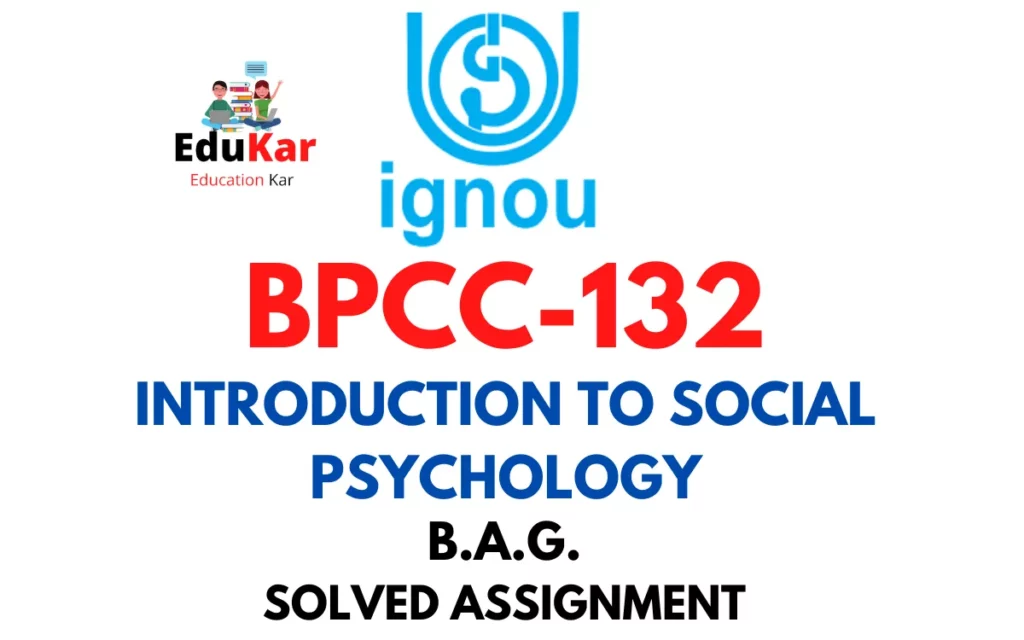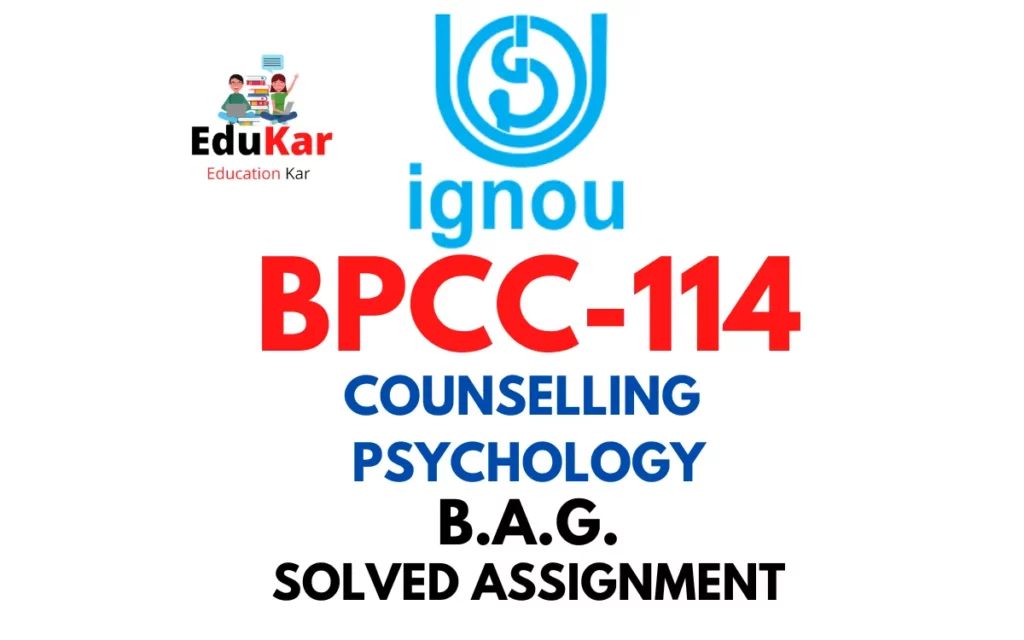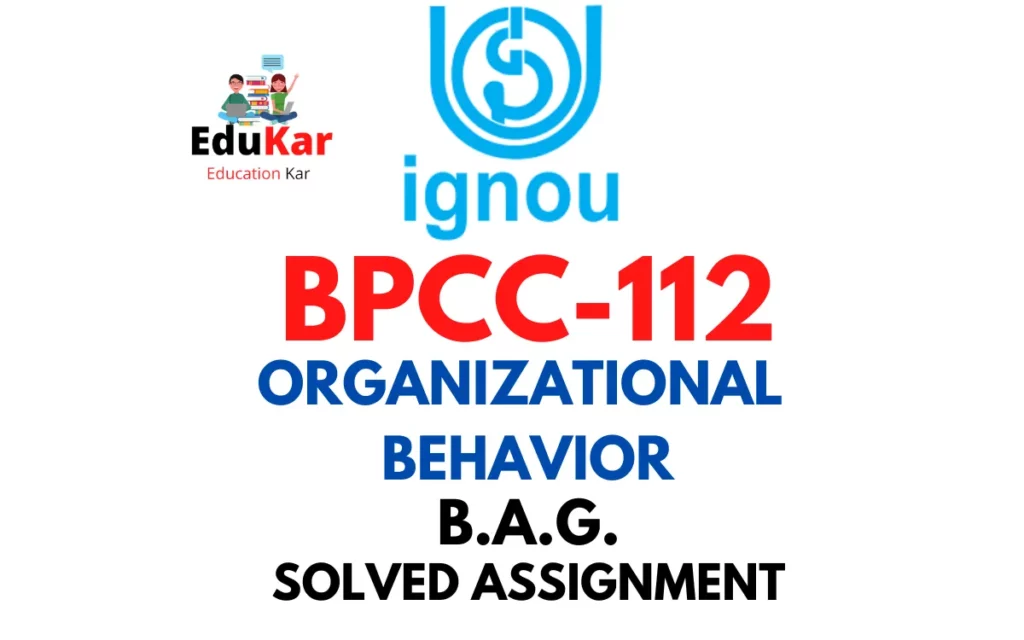Contents
- 1 PART A-Assignment One
- 2 Answer the following questions in about 500 words each. Each question carries 20 marks.
- 3 1. Define psychological disorder. Trace the history of psychological disorders.
- 4 2. Discuss the symptoms and causes of Cluster A Personality Disorders.
- 5 Assignment Two
- 6 Answer the following questions in about 100 words each. Each question carries 5 marks.
- 7 3. Types of Specific Phobias
- 8 4. Psychoanalytical perspective on Generalized Anxiety Disorder
- 9 5. Gender Dysphoria
- 10 6. Effect of alcohol on the brain
- 11 7. Autism Spectrum Disorder
- 12 8. Alzheimer’s Disease
- 13 PART B-Tutorial
- 14 ‘Make mental health and well-being for all a global priority’, is the theme of WorldMental Heath Day 2022. Write your perspective on the theme in light of the postpandemic situation across the globe.
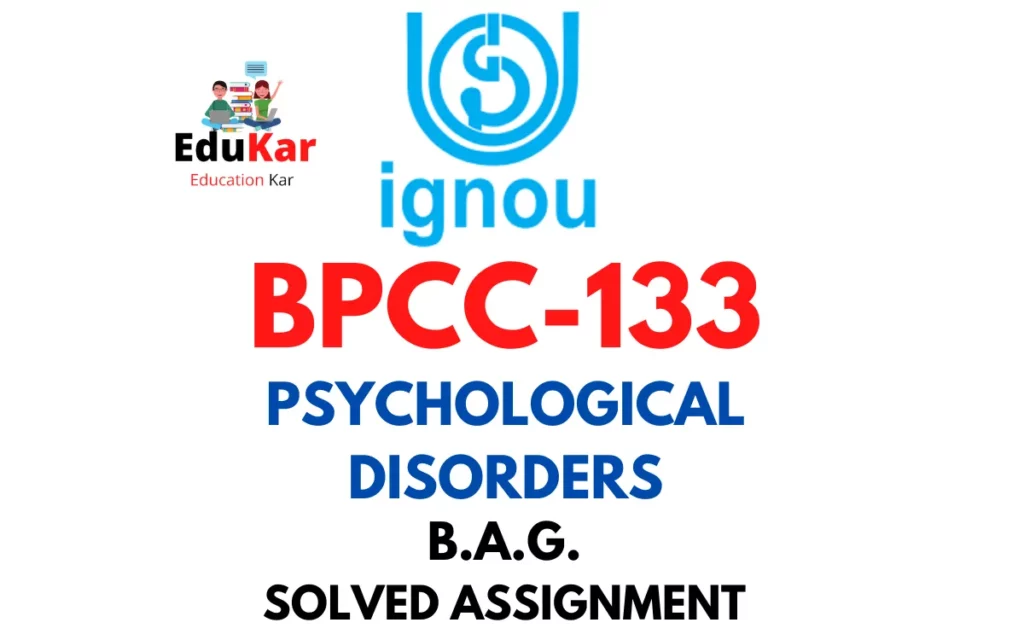
| Title | BPCC-133: IGNOU BAG Solved Assignment 2022-2023 |
| University | IGNOU |
| Degree | Bachelor Degree Programme |
| Course Code | BPCC-133 |
| Course Name | PSYCHOLOGICAL DISORDERS |
| Programme Name | Bachelor of Arts (General) |
| Programme Code | BAG |
| Total Marks | 100 |
| Year | 2022-2023 |
| Language | English |
| Assignment Code | Asst /TMA /July 2022 – January 2023 |
| Last Date for Submission of Assignment: | For June Examination: 31st April For December Examination: 30th September |
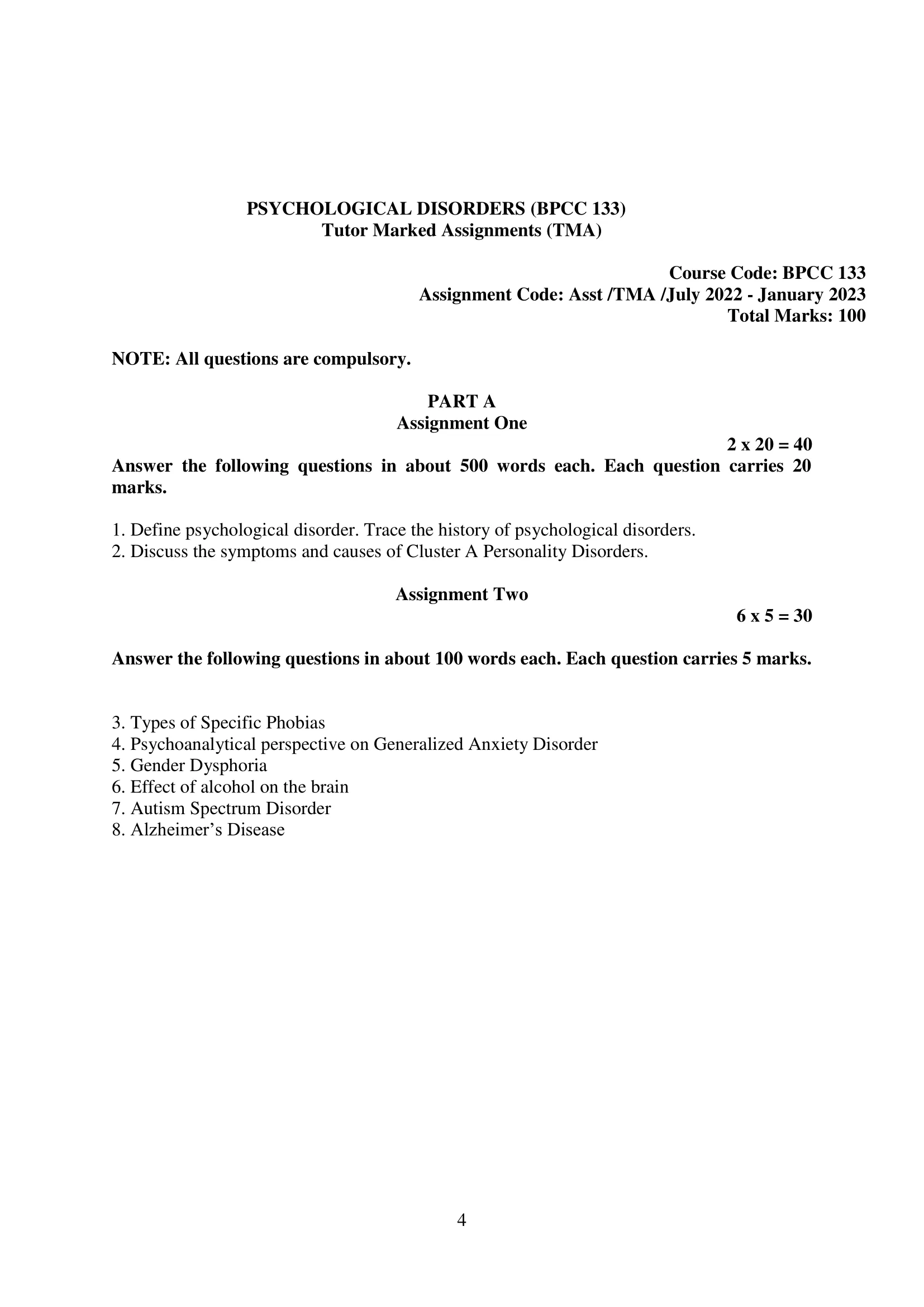
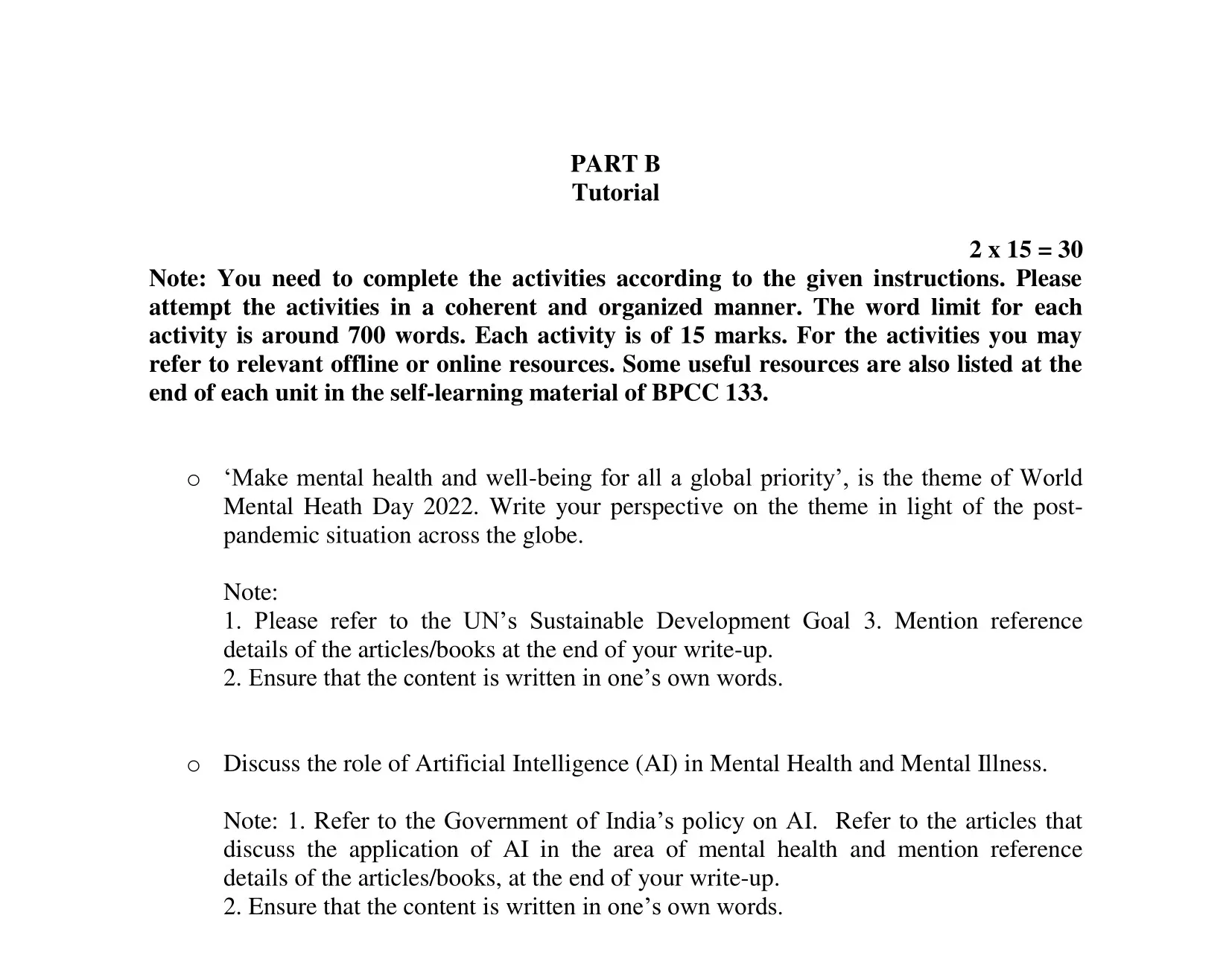
PART A-Assignment One
Answer the following questions in about 500 words each. Each question carries 20 marks.
1. Define psychological disorder. Trace the history of psychological disorders.
Ans: Psychological disorders are mental health conditions characterized by persistent patterns of thought, behavior, or emotion that significantly impair an individual’s ability to function in daily life. These disorders can cause significant distress or impairment in social, occupational, or other areas of functioning, and may be caused by a combination of biological, psychological, and social factors.
The history of psychological disorders is a long and complex one, with the concept of mental illness dating back to ancient times. In early civilizations, mental illness was often attributed to supernatural causes, such as possession by evil spirits or punishment from the gods. Treatment methods were often brutal and involved exorcism, torture, or other violent means of driving out the supposed evil spirits.
During the Middle Ages, mental illness was often seen as a form of witchcraft, and those suffering from mental illness were often persecuted as witches. In the 17th and 18th centuries, as scientific thinking began to take hold, mental illness was seen as a biological problem rather than a supernatural one. The first psychiatric hospitals were established during this time, and the focus of treatment shifted to institutionalization and confinement.
The 19th century saw the emergence of psychoanalysis, with Sigmund Freud and his followers developing theories about the unconscious mind and the role of childhood experiences in shaping adult behavior. This led to the development of talk therapies, such as psychoanalysis and psychotherapy, as well as the use of hypnosis as a treatment for mental illness.
In the 20th century, the field of psychology began to mature, and new treatments were developed, including behavioral therapy, cognitive therapy, and medication. The classification and diagnosis of mental disorders also became more standardized, with the development of the Diagnostic and Statistical Manual of Mental Disorders (DSM) and the International Classification of Diseases (ICD).
Today, the study of psychological disorders is a highly specialized field, with ongoing research and debate about the causes, treatments, and classification of mental illnesses. While our understanding of mental illness has come a long way from the days of exorcism and confinement, there is still much to learn, and many people around the world continue to struggle with the debilitating effects of mental illness.
2. Discuss the symptoms and causes of Cluster A Personality Disorders.
Ans: Cluster A Personality Disorders are a group of personality disorders characterized by odd, eccentric, or bizarre behaviors, thoughts, and emotions. The three types of Cluster A Personality Disorders are paranoid personality disorder, schizoid personality disorder, and schizotypal personality disorder. Each of these disorders has unique symptoms and causes.
Paranoid Personality Disorder: People with paranoid personality disorder are often suspicious and distrustful of others. They may be hypersensitive to perceived slights or criticism, and may react with anger or hostility when they feel threatened. Symptoms of paranoid personality disorder include:
- Suspicion and mistrust of others
- Constant vigilance for signs of betrayal or harm
- Inability to forgive perceived insults or injuries
- Tendency to hold grudges
- Hypersensitivity to criticism or rejection
- Reluctance to confide in others
The exact causes of paranoid personality disorder are unknown, but genetics and environmental factors may both play a role. People who have a family history of paranoid personality disorder or other mental health conditions may be at greater risk of developing the disorder. Childhood trauma or abuse, such as emotional or physical neglect, may also contribute to the development of paranoid personality disorder.
Schizoid Personality Disorder: People with schizoid personality disorder are often detached from social relationships and may prefer to spend time alone. They may appear cold or aloof and may have difficulty expressing emotions or connecting with others. Symptoms of schizoid personality disorder include:
- Limited range of emotional expression
- Difficulty forming close relationships
- Lack of interest in social activities
- Indifference to praise or criticism
- Preference for solitary activities
- Little or no desire for sexual experiences
The exact causes of schizoid personality disorder are not well understood, but genetics and environmental factors may both play a role. People who have a family history of schizophrenia or other mental health conditions may be at greater risk of developing the disorder. Childhood trauma or abuse, such as emotional or physical neglect, may also contribute to the development of schizoid personality disorder.
Schizotypal Personality Disorder: People with schizotypal personality disorder may have odd beliefs or behaviors, as well as difficulty forming close relationships. They may also experience perceptual distortions or magical thinking. Symptoms of schizotypal personality disorder include:
- Odd beliefs or magical thinking
- Unusual perceptual experiences, such as hearing voices or feeling like they are being watched
- Social anxiety or discomfort
- Limited range of emotional expression
- Suspiciousness or paranoia
- Eccentric behavior or appearance
The causes of schizotypal personality disorder are not well understood, but genetics and environmental factors may both play a role. People who have a family history of schizophrenia or other mental health conditions may be at greater risk of developing the disorder. Childhood trauma or abuse, such as emotional or physical neglect, may also contribute to the development of schizotypal personality disorder.
Assignment Two
Answer the following questions in about 100 words each. Each question carries 5 marks.
3. Types of Specific Phobias
Ans: Specific phobias are an anxiety disorder characterized by excessive and persistent fear and avoidance of a specific object or situation. There are various types of specific phobias, including animal phobias, natural environment phobias, blood-injection-injury phobias, situational phobias, and other phobias. Animal phobias involve excessive fear of specific animals or insects, while natural environment phobias involve excessive fear of specific natural phenomena such as thunderstorms or heights. Blood-injection-injury phobias involve excessive fear of needles or medical procedures. Situational phobias involve excessive fear of specific situations such as flying, driving, or enclosed spaces. Other phobias involve excessive fear of other specific objects or situations, such as clowns or vomiting. Treatment options for specific phobias include cognitive-behavioral therapy and exposure therapy.
4. Psychoanalytical perspective on Generalized Anxiety Disorder
Ans: Generalized Anxiety Disorder (GAD) is a mental health condition characterized by excessive and uncontrollable worry about a wide range of life circumstances. Psychoanalytic theory sees anxiety as a product of conflicts and unresolved emotional issues that can be traced back to early childhood experiences.
From a psychoanalytic perspective, Generalized Anxiety Disorder can be seen as a result of unconscious conflict between the ego, the id, and the superego. The id is the primitive part of the psyche that is driven by basic instincts such as the need for pleasure and the avoidance of pain. The superego represents the internalized moral values and norms of society, and the ego is the conscious part of the mind that mediates between the id and the superego.
The psychoanalytic approach to GAD suggests that the underlying cause of the disorder is an unresolved emotional conflict between the id and the superego. People with GAD may have an overactive superego that creates unrealistic and unattainable expectations, leading to feelings of guilt, shame, and anxiety. This overactive superego may have been created in childhood due to experiences such as overprotective parenting, neglect, or traumatic events.
Psychoanalytic therapy aims to help individuals with GAD explore their unconscious conflicts and the underlying emotional issues that contribute to their anxiety. The therapist helps the patient to understand the roots of their anxiety and to develop insight into their own emotional conflicts. Through this process, patients can learn to manage their anxiety by developing more adaptive coping mechanisms and by resolving their internal conflicts.
5. Gender Dysphoria
Ans: Gender dysphoria is a term used to describe the distress or discomfort experienced by individuals whose gender identity does not match the sex they were assigned at birth. It is considered a mental health condition in the Diagnostic and Statistical Manual of Mental Disorders, Fifth Edition (DSM-5).
From a psychological perspective, gender dysphoria is understood to arise from a conflict between an individual’s internal sense of gender identity and the gender that is assigned to them at birth. This conflict can lead to significant distress and impairment in a person’s social, occupational, and personal functioning.
Psychological treatments for gender dysphoria can include psychotherapy, hormone therapy, and gender-affirming surgery. Psychotherapy can help individuals explore their gender identity, address any internal conflicts they may have, and develop strategies for coping with the social and emotional challenges that come with gender dysphoria. Hormone therapy and gender-affirming surgery can help individuals align their bodies with their gender identity and alleviate the distress associated with gender dysphoria.
It is important to note that gender dysphoria is not a disorder that needs to be cured, and individuals with gender dysphoria should be treated with respect, support, and acceptance. Psychologists and mental health professionals should work with individuals to help them navigate their gender identity in a way that is affirming and respectful of their autonomy and personal values.
6. Effect of alcohol on the brain
Ans: Alcohol is a psychoactive substance that can affect the brain in a variety of ways. Here are some of the effects of alcohol on the brain:
- Impaired cognitive function: Alcohol can impair cognitive function, including memory, attention, and decision-making abilities. This can result in impaired judgment and a decreased ability to think clearly and make rational decisions.
- Changes in mood and behavior: Alcohol can affect mood and behavior, leading to increased aggression, impulsivity, and a reduced ability to control emotions. In addition, alcohol can cause depression and anxiety in some individuals.
- Interference with neurotransmitters: Alcohol interferes with the function of neurotransmitters in the brain, including GABA, glutamate, and dopamine. This can lead to a variety of effects, including impaired motor function, slowed reaction times, and altered perceptions of reality.
- Changes in brain structure: Prolonged and heavy alcohol use can lead to changes in brain structure, including shrinkage of the brain and damage to white matter. These changes can result in long-term cognitive and behavioral impairments, including memory problems and difficulties with decision-making.
- Addiction: Alcohol can be addictive, and repeated use of alcohol can lead to changes in the brain’s reward and pleasure systems. This can result in a strong desire to continue using alcohol despite negative consequences, leading to addiction.
7. Autism Spectrum Disorder
Ans: Autism Spectrum Disorder (ASD) is a neurodevelopmental disorder that affects social communication and interaction, as well as behavior and sensory processing. The symptoms of ASD can vary widely among individuals, and the condition is often diagnosed in early childhood.
Some common symptoms of ASD include:
- Difficulty with social communication: Individuals with ASD may struggle with social communication, such as understanding social cues, expressing emotions, and initiating or maintaining conversations.
- Repetitive behaviors or interests: People with ASD may engage in repetitive behaviors or have intense interests in specific topics or activities. These interests may be very focused and narrow, and individuals may struggle to engage in flexible thinking or adapt to changes in routine.
- Sensory processing difficulties: Individuals with ASD may have sensory processing difficulties, including hypersensitivity or hyposensitivity to sensory input. This can result in aversion or fascination with certain sensory experiences, such as loud noises or textures of food.
- Impaired motor skills: Some individuals with ASD may experience motor skills difficulties, including difficulties with balance, coordination, and fine motor skills.
The cause of ASD is not fully understood, but research suggests that it may be caused by a combination of genetic and environmental factors. There is no cure for ASD, but early intervention, including behavioral and educational interventions, can help individuals with ASD develop social, communication, and other life skills.
It is important to note that individuals with ASD have a unique set of strengths and challenges, and it is important to support their individual needs and strengths. With appropriate support and understanding, individuals with ASD can lead fulfilling and meaningful lives.
8. Alzheimer’s Disease
Ans: Alzheimer’s Disease is a neurodegenerative disorder that causes progressive cognitive decline, memory loss, and changes in behavior and personality. It is the most common cause of dementia, affecting millions of people worldwide. The disease typically affects older adults, with the risk of developing Alzheimer’s Disease increasing with age.
The exact cause of Alzheimer’s Disease is not fully understood, but researchers believe that it is caused by a combination of genetic, environmental, and lifestyle factors. The disease is characterized by the accumulation of beta-amyloid plaques and tau protein tangles in the brain, which leads to the death of brain cells and a loss of brain function over time.
The symptoms of Alzheimer’s Disease can vary widely, but common early signs include:
- Memory loss: Difficulty remembering newly learned information is often an early sign of Alzheimer’s Disease.
- Disorientation: People with Alzheimer’s Disease may become disoriented and confused, particularly in unfamiliar environments.
- Impaired judgment: Individuals with Alzheimer’s Disease may experience difficulties with decision-making and problem-solving.
- Personality and behavioral changes: Changes in personality and behavior, such as increased anxiety or depression, may occur as the disease progresses.
There is no cure for Alzheimer’s Disease, but treatment can help manage symptoms and slow the progression of the disease. Medications such as cholinesterase inhibitors and memantine can improve cognitive function and behavior, and lifestyle changes such as regular exercise, a healthy diet, and social engagement can also be helpful.
Caring for individuals with Alzheimer’s Disease can be challenging, and support from family, friends, and healthcare professionals is often necessary. Caregivers may benefit from education and support groups to help them manage the physical, emotional, and financial demands of caring for someone with Alzheimer’s Disease.
PART B-Tutorial
‘Make mental health and well-being for all a global priority’, is the theme of World
Mental Heath Day 2022. Write your perspective on the theme in light of the postpandemic situation across the globe.
Ans: The theme of World Mental Health Day 2022, “Make mental health and well-being for all a global priority”, is particularly timely in light of the post-pandemic situation across the globe. The COVID-19 pandemic has taken a significant toll on the mental health and well-being of people worldwide, with many experiencing increased levels of stress, anxiety, depression, and other mental health concerns. This has highlighted the urgent need to prioritize mental health and well-being for all.
The pandemic has brought to the forefront the importance of mental health and well-being as a global priority. People have experienced unprecedented levels of stress and anxiety due to the pandemic, including fear of illness, social isolation, financial stress, and uncertainty about the future. For many, the pandemic has exacerbated pre-existing mental health conditions or led to the development of new ones. Children and young people have also been particularly affected, with disruptions to their education, social lives, and routines.
The pandemic has also highlighted the inequalities in mental health care access and treatment. Many people, particularly those in low- and middle-income countries, do not have access to mental health services, and there is a significant treatment gap. Additionally, stigma and discrimination surrounding mental health continue to be significant barriers to care and treatment.
To make mental health and well-being for all a global priority, there must be a concerted effort to increase awareness, reduce stigma, and ensure that mental health services are available and accessible to all. Governments and policymakers should prioritize mental health in their policy decisions and allocate sufficient resources to address the mental health impact of the pandemic. This includes funding for mental health services and programs, as well as training for healthcare providers to address mental health concerns.
It is also crucial to involve communities and individuals in mental health promotion and prevention efforts. This includes promoting mental health literacy and providing support and resources to those in need. Communities can also play a significant role in reducing stigma and discrimination surrounding mental health by creating safe and supportive environments for those living with mental health conditions.
How to Download BPCC-133 Solved Assignment?
You can download it from the www.edukar.in, they have a big database for all the IGNOU solved assignments.
Is the BPCC-133 Solved Assignment Free?
Yes this is absolutely free to download the solved assignment from www.edukar.in
What is the last submission date for BPCC-133 Solved Assignment?
For June Examination: 31st April, For December Examination: 30th October

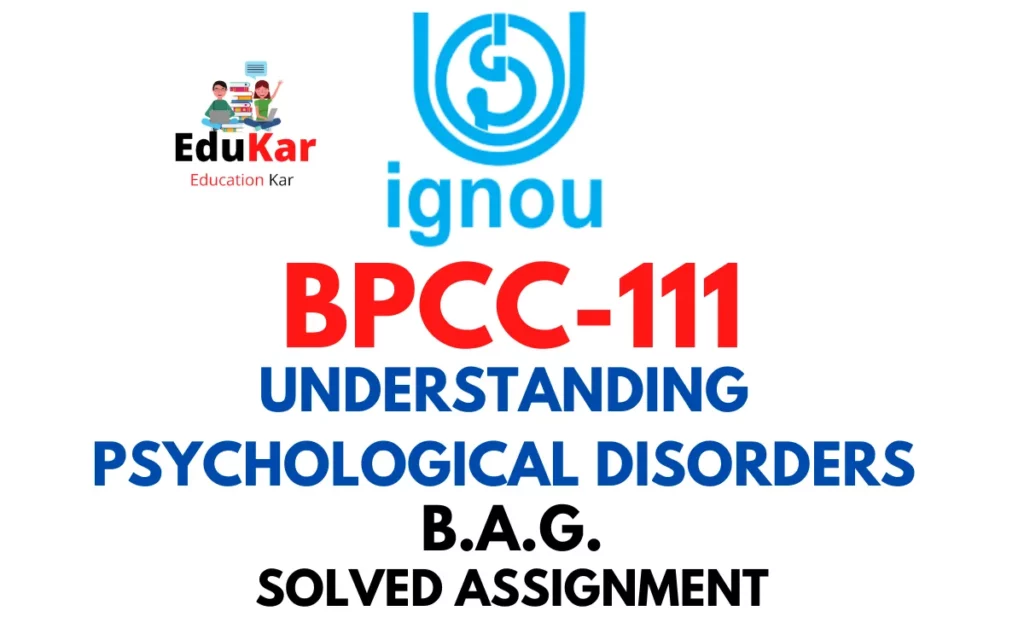


![[Solved Assignment] BPCS 188-APPLICATIONS OF SOCIAL PSYCHOLOGY (IGNOU-BAG) 2022-2023 BPCS 188-APPLICATIONS OF SOCIAL PSYCHOLOGY IGNOU BAG Solved Assignment 2022-2023](https://edukar.org/wp-content/uploads/2023/01/BPCS-188-APPLICATIONS-OF-SOCIAL-PSYCHOLOGY-IGNOU-BAG-Solved-Assignment-2022-2023-1024x640.webp)
